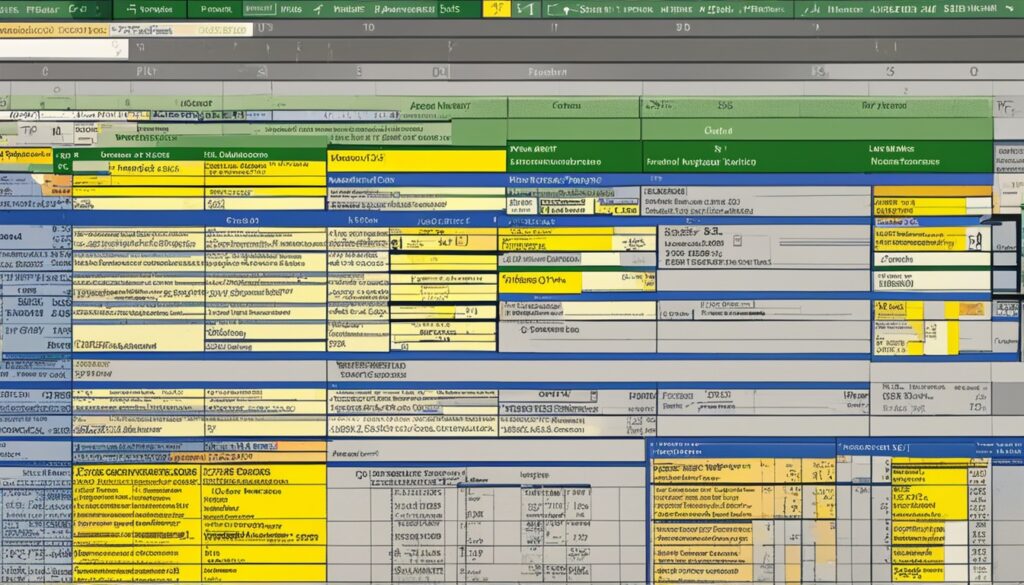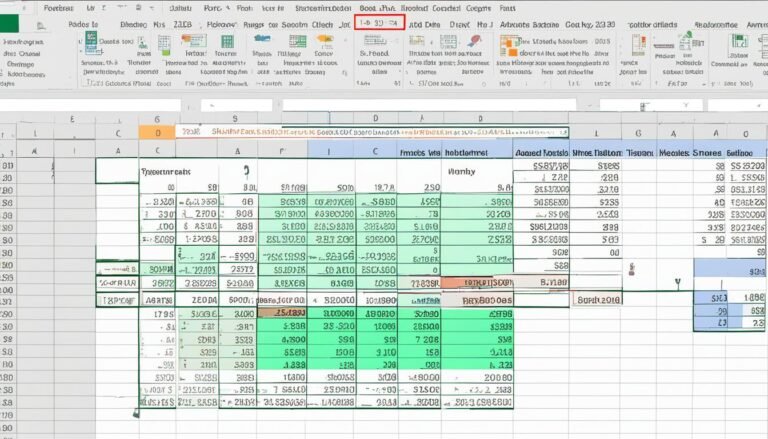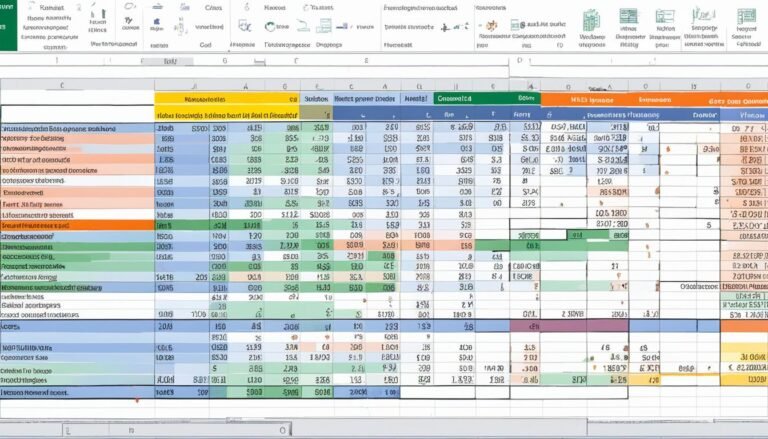Excel VLookup Function: A Comprehensive Guide
With over a decade of experience as an MS Excel expert, I confidently call the excel vlookup function one of Excel’s mightiest tools. It enables quick and precise vertical lookups. This is crucial for tasks like pricing based on part numbers or finding employee names via their IDs.
The excel lookup reference feature is at the heart of it all. It matches a value to the first column of a range, then grabs a value from a specific row and column. To make it work, you’ll need the excel data lookup, the lookup data’s table array, the return column, and an indication of a precise or close match.
The excel formula vlookup can greatly boost your Excel work. It makes hunting down data a breeze, saving time and ensuring correctness in analysis and reports.
This guide aims to make excel match function crystal clear. You’ll learn all you need to master it for your Excel tasks.
Key Takeaways
- The VLOOKUP function searches for a value in the first column of a range or table and returns a corresponding value from the same row.
- It compares the lookup value to the first column of the specified range and returns the value from the corresponding row and column.
- VLOOKUP requires the lookup value, table array, column number to return, and an optional argument for approximate or exact match.
- When used correctly, VLOOKUP enhances data analysis and reporting capabilities in Excel.
- This guide provides a comprehensive understanding of the VLOOKUP function and its applications.
What is the Excel VLOOKUP Function?
The VLOOKUP function in Excel is a key feature. It lets you search a range or table for a value. Then, it finds and reports a value from the same row in a different column. The “V” in VLOOKUP means “Vertical.” This suggests it searches through data in a top-to-bottom way.
Understanding VLOOKUP
VLOOKUP helps find information in a table from a given value. For example, you might look up a price from a product code or get an employee’s name using their ID number. It checks your selected value with the first column of data, then shows the matching info from a set column and row.
The Purpose of VLOOKUP
The main use of the VLOOKUP function is to make looking up data easy. It lets you find values fast and correctly based on certain details. This is handy with big amounts of data or when combining data from many places. It helps avoid mistakes you might make by looking up data by hand.
Learning to use VLOOKUP well improves how you work with data in Excel, whether you’re starting out or have some experience. This guide will show you the best ways to use VLOOKUP, like how to use it with different filters and in various workbooks.
The Syntax of VLOOKUP
Excel’s VLOOKUP has a specific way of working. It uses four parts we call arguments. As an expert, I’ll explain each one and what they do.
Lookup_value
The lookup_value is what you’re trying to find. It looks in the first column in a table or range. This might be a number, some text, or a cell’s content with the info you need.
Table_array
The table_array tells VLOOKUP where to find the info you want. It points to the whole range or table including the column titles. For example, if data’s in A1 to D10, you’d use A1:D10.
Col_index_num
The col_index_num shows which column has the answer you’re looking for. If you need to find what’s in the third column, you’d put 3 here.
Range_lookup
The range_lookup says if you need an exact or close match. You can set this to TRUE for close matches, or FALSE for an exact match.
How to Use VLOOKUP in Excel
Mastering the VLOOKUP function changes the game for Excel users. It’s crucial for handling data efficiently in Excel. I’ll help you get the hang of using VLOOKUP in Excel with clear steps.
Preparing Your Data
First, make sure your data is set up correctly before using VLOOKUP function. Your data’s lookup values should be in the first column. Then, place the related info in the next columns.
Identifying the Lookup Value
To start with VLOOKUP in Excel, find the value you need to look up. This value must be in the first column of your data.
Entering the VLOOKUP Function
Now, you’re ready to put in the VLOOKUP function. Type “=VLOOKUP(” in the formula bar or a cell, without quotes, to begin.
Supplying the Arguments
Next, you need to include four parts in the parentheses for the VLOOKUP function:
- The value you’re looking for
- The data table’s range
- The column number with the data you want
- Choose 0 for an exact match, 1 for a close match
Don’t forget to close the parentheses. Then, press Enter to see your result.
Practice is key to using the VLOOKUP function well. It might seem tricky at first, but you’ll get the hang of it with time. This tool can make data analysis tasks a lot easier in Excel.
VLOOKUP with Multiple Criteria
As an Excel vlookup function expert, I’ll show you a cool technique. It makes VLOOKUP look for things with more than one condition. This way, VLOOKUP can do searches using multiple criteria.
Let’s say you have a lot of info about employees. You want to know the salary of a certain employee. You need their department and job title to find this. VLOOKUP alone finds this hard. But, with INDEX and MATCH, you can do it. This makes a tough task easy with excel data lookup.
Here’s the trick: INDEX gets a value from a cell or range. MATCH tells you where a value is in a range. Put these in VLOOKUP. Now, you can find info based on many conditions. It makes your data work smarter.
Using VLOOKUP, INDEX, and MATCH makes excel formula vlookup better. You get data insights spot on. It’s precise data analysis at its best.
Imagine a table of employee details. You can make a formula to find a salary. It uses department and job title to match the employee. With VLOOKUP, INDEX, and MATCH, it’s easy. You search across columns at once. Data is found quickly and correctly.
- First, format your data into a table.
- Find the columns with the info you need (like department and job title).
- Use MATCH to get the right row numbers for the employee you’re looking for.
- Put these MATCHes in INDEX to get the salary value.
- Then, add VLOOKUP to finish the search with more than one criteria.
With this method, you get better at data analysis. Even very complex data is not a problem. You’ll pull out great insights effortlessly.
Using VLOOKUP with Multiple Spreadsheets
After teaching MS Excel for over 12 years, I found a game-changer in the excel vlookup multiple criteria function. It’s key when you need to gather data spread across many files. This feature helps by looking up info from one sheet and pulling data from another, even among different workbooks.
Imagine needing to mix info from various spreadsheets. Let’s say you have a list of products and another with sales data. Using excel vlookup multiple criteria, you can easily connect the product codes to get detailed info. It makes managing multiple files a breeze.
The excel vlookup multiple criteria function empowers you to seamlessly integrate data from various sources, streamlining your workflow and enhancing the accuracy of your analysis.
Here’s a simple example to illustrate how it works:
| Product Code | Product Name | Price |
|---|---|---|
| P001 | Widget X | $9.99 |
| P002 | Gadget Y | $14.99 |
| P003 | Thingamajig Z | $19.99 |
Let’s say you have products’ names and prices in one file. In another, you have the products bought and their numbers. By linking the product codes, excel vlookup multiple criteria helps you make detailed reports. This is all without manually merging files.
For finance, inventory, or customer data, excel vlookup multiple criteria is essential. It helps you find key insights. And empowers better decisions with ease.
Using VLOOKUP with Multiple Workbooks
As an excel lookup reference expert, I often use data from many workbooks. Excel’s VLOOKUP makes it easy to get data from different files. Here’s how to do it.
Opening Both Workbooks
First, make sure both the file with the lookup info and the one with the data are open. This is key for VLOOKUP to work with many workbooks.
Identifying the Lookup Value
Next, find the data point you need for your search. It must be in the first column of the data range.

Entering the VLOOKUP Formula
Then, in the result cell, type your VLOOKUP formula. Include these parts:
- The data point (usually a cell)
- The data range from the other file, with its name and sheet’s name (like ‘[OtherWorkbook.xlsx]Sheet1’!$A$1:$D$1000)
- The column number from this range to pull the info from
- Optionally, say if you want exact or close matches (TRUE or FALSE)
Don’t forget to lock the range by putting $ signs before the cell addresses. This prevents errors when you copy the formula.
Reviewing and Adjusting the Result
After typing the formula, Excel will look up the value for you. Check if the result is right. If not, you may need to tweak the formula or the data.
Using VLOOKUP with several workbooks can make your data work faster. It’s useful for many tasks, ensuring your work is both fast and accurate.
Tips for Using VLOOKUP Efficiently
After teaching Excel for over 12 years, I’ve seen the power of VLOOKUP. To use it well, there are key strategies. These tips will make your excel vlookup tutorial work smoother and boost your productivity.
Organizing Data
Good data setup is key for VLOOKUP. Make sure your lookup column is in order and clean. No blank cells or duplicates. This stops errors and gets you the right results.
Understanding Data Structure
Know your data well before using VLOOKUP. Figure out the lookup column and where your needed values are. Knowing this can help avoid mistakes and save time later.
Using Named Ranges
Named ranges are a good idea for your lookup table. They make your excel vlookup tutorial formulas clearer. They’re also easier to update and help avoid cell shifting errors.
Handling Errors
Sometimes VLOOKUP gives errors like #N/A or #REF!. To fix them, make sure your data types match. Then, use IFERROR to show a different message when there’s an error.
| Error | Description | Solution |
|---|---|---|
| #N/A | Indicates that the lookup value is not found in the lookup column. | Check for typos or formatting issues in the lookup value or lookup column. |
| #REF! | Occurs when the cell references in the VLOOKUP formula are invalid or point to a non-existent range. | Review the cell references in the formula and ensure they are correct and pointing to the intended range. |
Limitations of VLOOKUP
The VLOOKUP function in Excel is very useful for finding data vertically. But, it does have some drawbacks you should know about. I’ll go over a few of these now:
Left-to-Right Lookup
VLOOKUP works just from left to right. This means, your search value must be in the leftmost column. If it’s not there, VLOOKUP won’t be able to find the data you need. In such situations, you may want to check out functions like HLOOKUP or INDEX-MATCH.
Duplicate Values in Lookup Column
Sometimes, you might have the same value appear more than once in the first column. If this happens, VLOOKUP will only find the first instance. That might not give you the right answer. To fix this, consider using functions like INDEX-MATCH. Or, try arranging your data to avoid duplicates in the first column.
Sensitivity to Column Insertion/Deletion
Another issue with VLOOKUP is how it can get thrown off if you add or remove columns. It uses the column number to know where to grab data from. Changing your table’s structure means adjusting your VLOOKUP formulas. This step is prone to errors and can be quite tedious, especially with lots of formulas. Named ranges and INDEX-MATCH can help you avoid this problem.
In light of these issues, VLOOKUP is still a key tool for vertical searches in Excel, especially for orderly data. It’s good to know its limits and be ready to explore other methods when needed.
VLOOKUP in Financial Modeling
After teaching Excel for over 12 years, I’m certain the VLOOKUP function is a must-know in financial modeling. It allows for creating models that fit different scenarios and data sources. This makes financial analysis more accurate and relevant.
Dynamic Scenario Analysis
VLOOKUP is great for dynamic scenario analysis. It’s key in financial modeling to look at different scenarios’ impacts on metrics. With VLOOKUP, linking to external data lets me change input values to see the model’s changes instantly.
Imagine we’re analyzing a manufacturing firm’s sales forecast effects on revenue. Using VLOOKUP, I connect the model to a sales forecast table. Then, changing the excel formula vlookup updates the model. This shows the new financial picture with just a few clicks.
Incorporating Data from External Sources
VLOOKUP shines in pulling data from external sources. Financial models often need info from various systems. VLOOKUP fetches these external data efficiently, without manual data entry, and reduces errors.
Take needing current exchange rates for your model. With VLOOKUP, you access live or recent data without updating by hand. This automation keeps models current and accurate, saving you time.
VLOOKUP boosts the quality of financial analyses. With it, models become more reliable, adaptable, and support smarter decisions.
Conclusion
After more than 12 years specializing in Excel, I truly believe the VLOOKUP function is crucial. It’s ideal for searching data tables. For example, you can find a product’s price by its code or look up an employee’s name by their ID.
Knowing how VLOOKUP works is key. It involves several parts, like what you’re looking for, where to look, and which part of the data to return. Understanding this can unlock the power of VLOOKUP.
Yet, VLOOKUP isn’t perfect. It mainly looks from left to right, which can be a downside. But, you can get around this by combining it with other functions. For instance, using MATCH with VLOOKUP can offer even more flexibility.
FAQ
What is the purpose of the VLOOKUP function in Excel?
The VLOOKUP function is a key tool in Excel. It helps in searching for values in a table. It then pulls out matching data from another column. This is useful for many tasks, like finding prices from part numbers.
What are the arguments required for the VLOOKUP function?
VLOOKUP needs four things to work. You must specify what value to look up. Tell it where to find the data. Pick which column to get the matched value from. Decide if you want an exact or close match.
How can I prepare my data for using VLOOKUP effectively?
Getting your data ready is key for VLOOKUP to work right. Make sure your lookup value is in the first column. Also, sort your data by that first column. Don’t have any blanks in the data.
Can VLOOKUP handle multiple criteria lookups?
VLOOKUP is great for looking up one thing at a time. But, it can work with other functions to do more complex searches. This can be helpful when you need to find data using many different conditions.
How can I use VLOOKUP with multiple spreadsheets or workbooks?
To use VLOOKUP across different files, open both. Then, set your lookup value. Use the VLOOKUP formula with the right file references. Finally, check and adjust your work as needed.
What are some tips for using VLOOKUP efficiently?
To use VLOOKUP well, organize your data clearly. Know your data structure well. Use named ranges to keep things clear. And, know how to manage errors with tools like ISNA.
What are the limitations of VLOOKUP?
VLOOKUP does have its limits. It can only search from left to right in a table. It can’t handle duplicates in the first column. And, it’s sensitive to changes in the data, like adding or deleting columns. Plus, it can’t handle multiple criteria searches easily.
How is VLOOKUP useful in financial modeling?
VLOOKUP is vital in finance for creating dynamic models. It allows for different scenarios and data sources. This makes it great for deep financial analyses and including data from various places.





